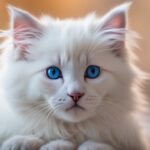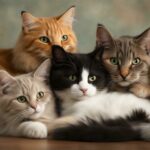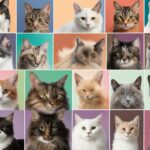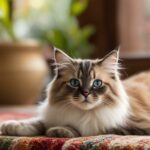Ragdoll cats are known for their stunning appearance and docile nature, but they often come with a hefty price tag. In this article, I will explore the factors that contribute to the high cost of Ragdoll cats, including their unique physical characteristics, rarity, and demand in the feline market. We’ll delve into the breed’s history, genetics, and the care required for these special cats.
Key Takeaways:
- Ragdoll cats are expensive due to their unique physical characteristics, rarity, and demand in the market.
- The breed’s history and genetics play a role in determining their price.
- Proper care and grooming are essential for the health and well-being of Ragdoll cats.
- Ragdolls are ideal family pets but also make great companions for individuals seeking a low-maintenance pet.
- Rare markings and colors of Ragdolls add to their appeal and value.
The History and Origin of Ragdoll Cats
The fascinating history of Ragdoll cats dates back to the 1960s when breeder Ann Baker created this unique breed in Riverside, California. Although the exact origin of the breed is shrouded in mystery, one popular story suggests that Baker selectively bred domestic longhaired cats, using a white Persian named Josephine as the foundation. Josephine’s gentle and trusting nature became a defining characteristic of the Ragdoll breed. However, the claim that Ragdolls go limp when picked up due to a genetic mutation remains controversial.
Regardless of their origins, Ragdolls quickly gained popularity for their striking appearance and friendly temperament. They are now recognized by cat registries worldwide and are cherished by cat enthusiasts.
To learn more about the history and origin of Ragdoll cats, refer to the table below:
| Year | Event |
|---|---|
| 1960s | Ann Baker develops the Ragdoll breed in Riverside, California |
| 1975 | Formation of the Ragdoll Fanciers Club International (RFCI) |
| 1993 | Recognition of the Ragdoll breed by The International Cat Association (TICA) |
| 1999 | The Governing Council of the Cat Fancy (GCCF) recognizes the Ragdoll breed in the United Kingdom |
As the breed continues to capture the hearts of cat lovers around the world, the history and origin of Ragdoll cats remain an intriguing part of their allure.
Ragdoll Cat’s Unique Physical Characteristics
Ragdoll cats possess distinct physical characteristics that set them apart from other cat breeds. Their size, coat, and temperament contribute to their unique appeal. Here are some key features of Ragdoll cats:
- Size: Ragdolls are one of the largest domestic cat breeds. Male Ragdolls typically weigh between 15 to 20 pounds, while females are slightly smaller.
- Coat: Ragdolls have a semi-longhair coat that is soft and silky to the touch. Their fur requires regular grooming to prevent matting and tangling.
- Temperament: Ragdolls are known for their gentle and friendly temperament. They have a calm and easy-going nature, making them ideal companions.
These physical characteristics, combined with their striking appearance and unique behavior, make Ragdoll cats highly sought after by cat lovers.
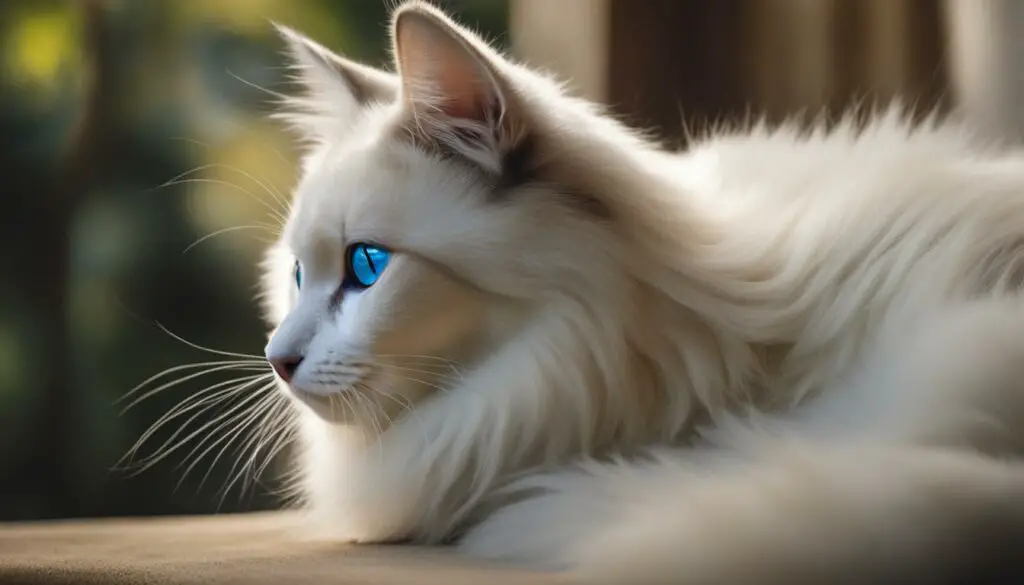
Table: Size Comparison of Ragdoll Cats with Other Breeds
| Breed | Weight Range (Male) | Weight Range (Female) |
|---|---|---|
| Ragdoll | 15-20 pounds | 10-15 pounds |
| Maine Coon | 15-25 pounds | 10-15 pounds |
| Persian | 9-14 pounds | 7-11 pounds |
Ragdolls are often described as “gentle giants” due to their large size and calm temperament.
These physical characteristics make Ragdoll cats both visually striking and delightful companions for cat enthusiasts.
Personality Traits and Temperament of the Ragdoll Breed
The Ragdoll breed is known for its unique personality traits and gentle temperament. These cats have a calm and easy-going nature, making them ideal companions for families and individuals alike. Ragdolls are often described as affectionate, friendly, and sociable, creating strong bonds with their owners.
One of the defining traits of Ragdolls is their docility. They are generally relaxed and enjoy being held and cuddled. In fact, they are known for a behavior called “going limp” when picked up, which adds to their charm and endears them to cat lovers. This behavior is a testament to their trusting and gentle nature.
Ragdolls are highly social animals and thrive on human interaction. They are often found following their owners from room to room and enjoy being involved in daily activities. They are not demanding or overly vocal, but they do appreciate attention and affection. Ragdolls also get along well with children and other pets, making them a great choice for families.
| Personality Traits | Temperament | Social Nature |
|---|---|---|
| Docile | Calm | Affectionate |
| Gentle | Easy-going | Friendly |
| Trusting | Relaxed | Sociable |
Ragdoll cats are not only wonderful companions but also highly adaptable. They can easily adjust to different environments and are not prone to anxiety or excessive stress. This makes them suitable for various living situations, whether it’s a busy household or a quieter setting.
Quote:
“Ragdolls have the most amazing temperament. They are calm, gentle, and loving. They bring so much joy and happiness to our family.” – Cat owner
Caring for and Grooming Your Ragdoll Cat
Proper care and grooming are essential to keeping your Ragdoll cat healthy and happy. Here are some tips to help you provide the best care for your feline friend:
Grooming
- Brush your Ragdoll’s coat regularly to prevent matting and tangles. Use a soft-bristle brush or a comb specifically designed for longhaired cats.
- Pay special attention to your Ragdoll’s undercoat, as it can easily become tangled. Gently comb through the fur to remove any knots.
- Check your cat’s ears regularly for signs of infection or excessive wax buildup. Use a vet-approved ear cleaner to keep the ears clean and healthy.
- Trim your Ragdoll’s nails regularly to prevent them from becoming too long or sharp. Be cautious not to cut the quick, which can cause bleeding and discomfort.
- While Ragdolls are known for their low-maintenance coats, occasional bathing may be necessary to keep their fur clean and smelling fresh. Use a gentle cat shampoo and rinse thoroughly.
Exercise
- Provide your Ragdoll cat with regular opportunities for exercise. Engage them in interactive play sessions using toys, feathers, or laser pointers to keep them active and stimulated.
- Consider providing climbing structures and scratching posts for your Ragdoll to satisfy their natural instincts and keep them physically active.
- Set aside dedicated playtime each day to ensure your cat gets the exercise they need. This not only promotes physical health but also strengthens the bond between you and your feline companion.
Nutrition
- Feed your Ragdoll cat a well-balanced diet that meets their specific nutritional needs. Look for high-quality cat food that is formulated for their life stage.
- Avoid overfeeding your Ragdoll, as they can be prone to weight gain. Follow the feeding guidelines provided by your veterinarian and monitor your cat’s weight to maintain a healthy body condition.
- Provide fresh water at all times and ensure that your Ragdoll has access to it throughout the day.
By following these grooming, exercise, and nutrition tips, you can help ensure your Ragdoll cat remains healthy, happy, and well-cared for. Remember to consult with your veterinarian for personalized advice and recommendations based on your cat’s specific needs.
Table: Common Grooming Tools for Ragdoll Cats
| Grooming Tool | Description |
|---|---|
| Slicker Brush | A brush with fine, short wires close together that removes loose fur and prevents matting. |
| Wide-Tooth Comb | A comb with widely spaced teeth that helps detangle and remove knots from the fur. |
| Nail Clippers | Specifically designed clippers for trimming your cat’s nails without causing discomfort. |
| Ear Cleaner | A vet-approved solution to clean your cat’s ears and prevent infection. |
| Cat Shampoo | A gentle shampoo formulated for cats to keep their fur clean and healthy. |
Ragdoll Cats: Ideal Family Pets or Solo Companions?
When it comes to choosing a pet, Ragdoll cats are a popular choice for both families and individuals seeking a loyal and loving companion. Their friendly and affectionate nature makes them well-suited for households with children and other pets, earning them the reputation of being ideal family pets. Ragdolls have a calm and patient temperament, which allows them to adapt well to different environments and become an integral part of the family dynamics.
However, Ragdolls are also well-suited as solo companions for those seeking a low-maintenance pet. They form strong bonds with their owners and enjoy human interaction, whether in a bustling household or a quieter environment. Ragdolls are not demanding and are content spending time alone, making them an excellent choice for individuals looking for a loyal and independent feline friend.
“Ragdolls are known for their friendly and affectionate nature, making them excellent family pets. They get along well with children and other pets, thanks to their calm and patient temperament.”
| Ragdolls as Family Pets | Ragdolls as Solo Companions |
|---|---|
|
|
Whether as a family pet or a solo companion, Ragdoll cats bring joy and companionship to their owners. Their loving and gentle nature, combined with their adaptability, make them a wonderful addition to any household. Whether you have a bustling family life or prefer a quieter environment, Ragdolls are the perfect feline friend to brighten your days and warm your heart.
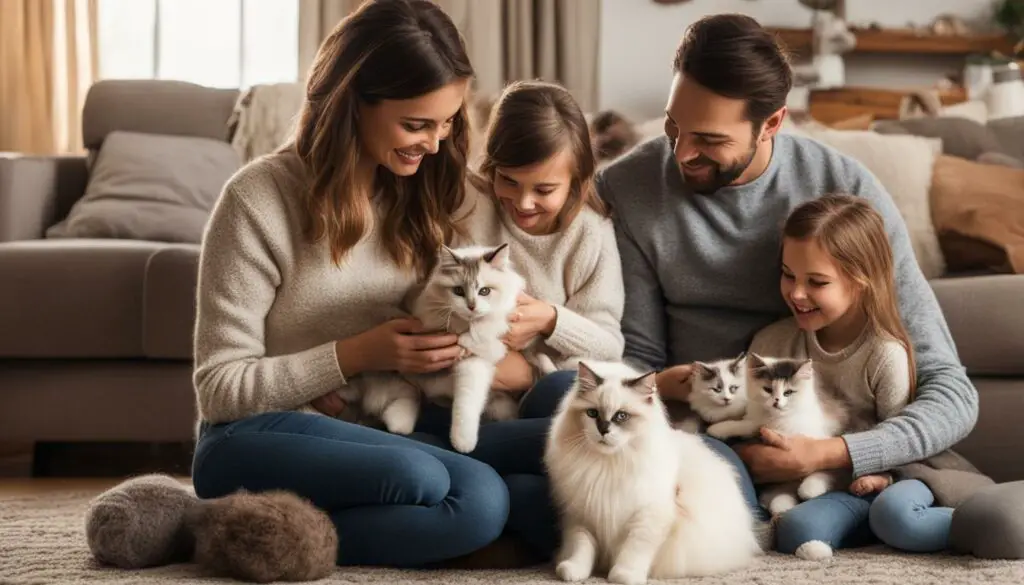
The History and Origin of Ragdoll Cats
The history of Ragdoll cats is a captivating tale that is intertwined with legends and controversies. While the exact origins of the breed may remain a subject of debate, there is no denying the beauty and charm of these felines. Created in the 1960s by breeder Ann Baker in Riverside, California, Ragdolls quickly gained popularity for their calm temperament and friendly demeanor.
According to one popular story, Baker selectively bred domestic longhaired cats, using a white Persian named Josephine as the foundation. Josephine’s gentle and trusting nature, along with her striking blue eyes, became defining characteristics of the Ragdoll breed. Over time, Ragdolls became recognized by major cat registries worldwide and are now cherished by cat enthusiasts.
“The Ragdoll breed has a fascinating history that is intertwined with legends and controversies.”
The origin of the name “Ragdoll” is also shrouded in mystery. Some believe that it was inspired by the breed’s tendency to go limp and relax when picked up, just like a ragdoll. However, this claim remains disputed and controversial.
| Ragdoll Cat History | Ragdoll Cat Origin |
|---|---|
| The breed was created in the 1960s by breeder Ann Baker | The exact origin of the breed is still debated |
| Ragdolls quickly gained popularity for their calm temperament and friendly demeanor | Some believe the breed was developed by selectively breeding domestic longhaired cats using a white Persian named Josephine as the foundation |
| The breed is recognized by major cat registries worldwide | The name “Ragdoll” is believed to be inspired by the breed’s tendency to go limp when picked up, although this claim is disputed |
The history and origin of Ragdoll cats add to their allure, making them a beloved breed among cat lovers worldwide.
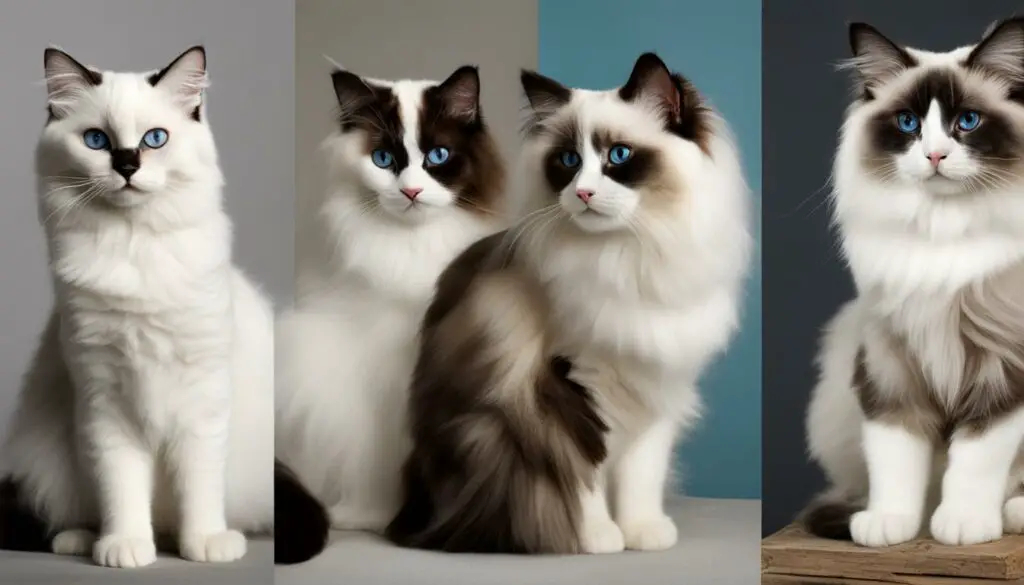
Ragdoll Cat’s Unique Physical Characteristics
Ragdoll cats possess several remarkable physical characteristics that make them stand out among other breeds. They are known for their large size, with males weighing between 15 to 20 pounds on average. Their docile and calm nature, combined with their size, gives them an almost doll-like appearance. Ragdolls have a semi-longhair coat that is soft and silky to the touch. The coat comes in various colors and patterns, and their eye-catching blue eyes add to their charm. Additionally, Ragdolls are known for their tendency to go limp when picked up, a unique behavior that further enhances their gentle and friendly temperament.
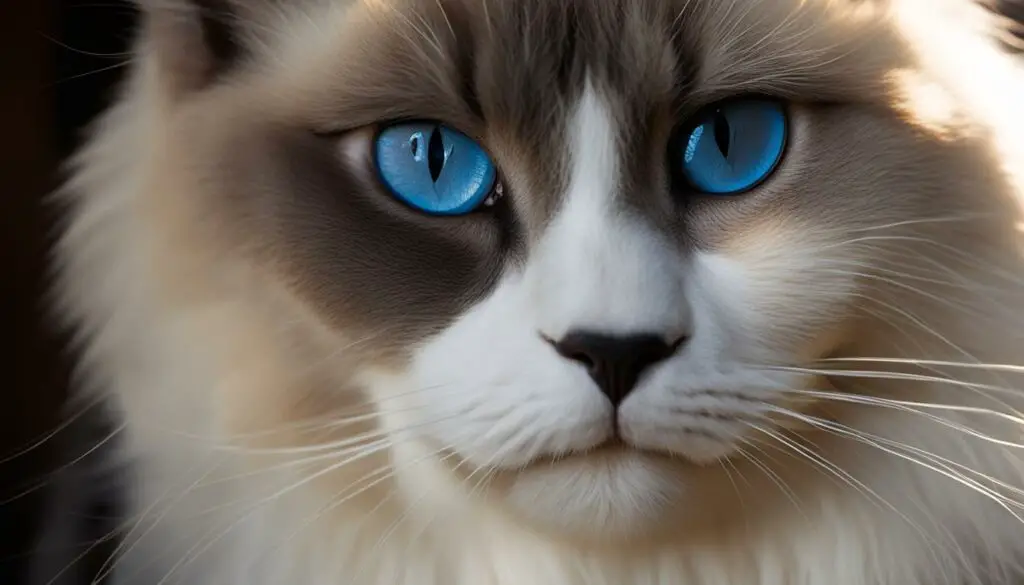
Comparative Characteristics of Ragdoll Cats
| Characteristics | Ragdoll Cats | Other Cat Breeds |
|---|---|---|
| Size | 15 to 20 pounds on average | Varies by breed |
| Coat Length | Semi-longhair | Varies by breed |
| Coat Texture | Soft and silky | Varies by breed |
| Coat Colors and Patterns | Various, including colorpoint and mitted | Varies by breed |
| Eye Color | Blue | Varies by breed |
| Temperament | Gentle and friendly | Varies by breed |
As seen in the table above, Ragdoll cats have distinct characteristics that set them apart from other cat breeds. Their large size, soft coat, and unique coat patterns make them visually striking. Their blue eyes and tendency to go limp when held make them even more endearing. Additionally, Ragdolls’ gentle and friendly temperament makes them great companions, both for individuals and families alike.
Personality Traits and Temperament of the Ragdoll Breed
Ragdoll cats have a unique personality and temperament that sets them apart from other breeds. Known for their gentle and affectionate nature, Ragdolls make wonderful companions for individuals and families alike. They are often described as docile, friendly, and easy-going, making them a joy to have around.
Ragdolls are highly sociable cats and thrive on interaction with their human companions. They enjoy being around people and will often seek out attention and affection. Whether it’s curling up on your lap or following you around the house, Ragdolls love to be by your side. Their social nature makes them an ideal choice for those seeking a feline friend that will always be there for them.
In addition to their sociability, Ragdolls are also known for their intelligence and adaptability. They are quick learners and can be easily trained to perform tricks or respond to commands. Their calm and patient demeanor allows them to get along well with children and other pets, making them a perfect fit for families.
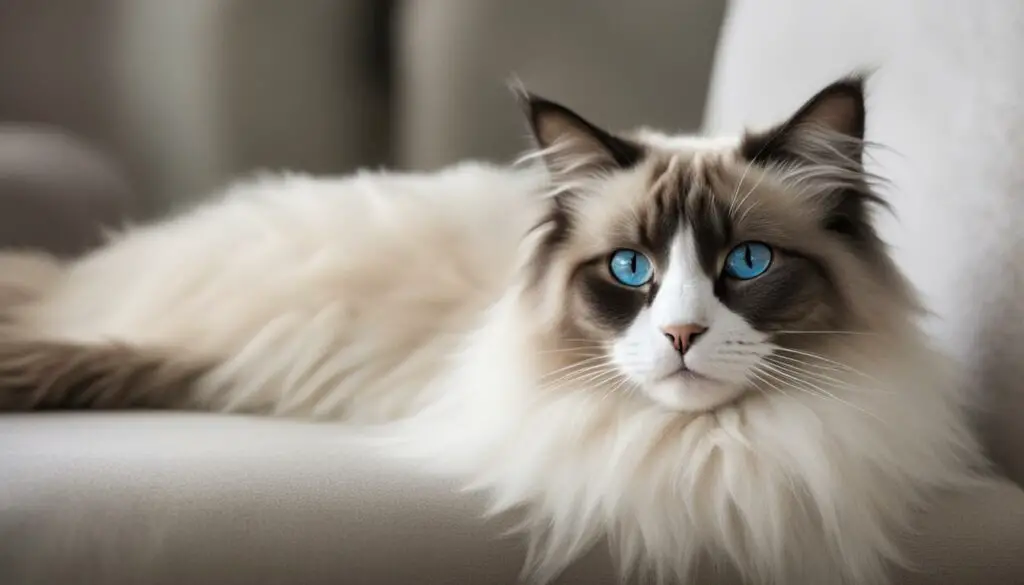
Overall, Ragdolls are the epitome of a gentle and friendly cat breed. Their loving nature, sociability, and intelligence make them excellent companions for any cat lover. Whether you’re looking for a solo companion or a family pet, Ragdolls will bring joy and warmth to your home.
Caring for and Grooming Your Ragdoll Cat
Proper care and grooming are vital for the health and well-being of your Ragdoll cat. These beautiful felines require regular attention to maintain their semi-longhair coat and overall physical wellness.
Grooming Tips:
- Regular brushing: Use a comb or brush specifically designed for longhair cats to prevent matting and tangling of the fur. Aim to brush your Ragdoll at least once a week, increasing the frequency during shedding seasons.
- Ear cleaning: Check your cat’s ears regularly for any signs of wax buildup or infections. Use a vet-approved ear cleaning solution and a cotton ball to gently clean the outer part of the ears.
- Nail trimming: Trim your cat’s nails regularly to prevent them from becoming too long or sharp. Use cat nail clippers or ask your veterinarian for guidance on how to safely trim your Ragdoll’s nails.
- Oral hygiene: Dental health is crucial for your cat’s overall well-being. Brush your Ragdoll’s teeth regularly using a cat-specific toothbrush and toothpaste. Additionally, providing dental treats or toys can help maintain oral hygiene.
Exercise and Nutrition:
While Ragdolls are known for their calm and easy-going temperament, it’s important to provide them with regular exercise to prevent obesity and promote muscle tone. Interactive play sessions with toys and climbing structures can keep them physically and mentally stimulated. Additionally, feeding your Ragdoll a well-balanced diet that meets their nutritional needs is crucial for their overall health. Consult with your veterinarian to determine the appropriate portion sizes and types of food for your cat.
Remember to schedule regular veterinary check-ups for your Ragdoll cat to ensure they receive essential vaccinations and preventive care. Your veterinarian can provide personalized recommendations for your cat’s specific needs and help you establish a comprehensive care routine that will keep your Ragdoll happy and healthy for years to come.
| Grooming Tips for Ragdoll Cats | Exercise for Ragdolls | Nutrition for Ragdoll Cats |
|---|---|---|
| Regular brushing to prevent matting and tangling of the fur | Provide interactive play sessions and climbing structures | Feed a well-balanced diet tailored to their nutritional needs |
| Clean the ears regularly to prevent wax buildup and infections | Promote physical and mental stimulation with toys and activities | Consult with your veterinarian for portion sizes and food types |
| Trim the nails regularly to prevent them from becoming too long or sharp | Prevent obesity by ensuring regular exercise routines | Consider dental treats or toys to maintain oral hygiene |
| Brush the teeth regularly using cat-specific toothbrush and toothpaste | Monitor weight and adjust diet and exercise accordingly | Schedule regular veterinary check-ups for preventive care |
Ragdoll Cats: Ideal Family Pets or Solo Companions?
When it comes to choosing a feline companion, Ragdoll cats are an excellent option. Their friendly and affectionate nature makes them ideal for families and individuals alike. They love being around people and get along well with children and other pets, thanks to their calm and patient temperament.
Ragdolls adapt well to different environments and become an integral part of the family dynamics. Whether it’s playing with kids or curling up for a cozy cuddle session, Ragdolls bring joy and companionship to the entire family. Their sociable nature and strong bonds with their owners make them an excellent choice for those seeking a loyal and loving pet.
However, Ragdoll cats are also suitable as solo companions for individuals who prefer a quieter environment. Despite their social nature, they are content spending time alone. Ragdolls form deep connections with their owners and enjoy human interaction, regardless of the household dynamics. Whether you are part of a bustling family or prefer a more peaceful setting, Ragdolls will bring love and companionship to your life.
| Ragdolls as Family Pets | Ragdolls as Solo Companions |
|---|---|
| Ragdolls have a calm and patient temperament, making them great with children. | Ragdolls are content spending time alone and enjoy human interaction. |
| They get along well with other pets, making them a great addition to multi-pet households. | They form deep bonds with their owners, providing loyal companionship. |
| Ragdolls adapt well to different household dynamics, thriving in family environments. | They are low-maintenance pets, suited for individuals seeking a quiet and peaceful bond. |
| Ragdolls bring joy and love to the entire family, engaging in playful behavior and providing endless affection. | Whether it’s a bustling household or a quieter setting, Ragdolls will be by your side, bringing comfort and companionship. |
Rare Markings and Colors of Ragdoll Cats
Ragdoll cats are known for their stunning colorpoint patterns, but there are also rare and unique markings and colors that make them even more captivating. These rare markings add an extra touch of allure to these already beautiful cats. Examples of rare markings found in Ragdolls include Lynx Point, Tortie Point, Blaze, Van, and Mitted. Each of these markings possesses its own rarity and contributes to the overall charm of these felines.
In addition to rare markings, there are also rare colors that can be found in Ragdolls. These unique color combinations further enhance the visual appeal of these cats. From rare and elusive patterns to unusual coat colors, Ragdolls come in a variety of captivating shades. Whether it’s a rare colorpoint pattern or a one-of-a-kind coat color, these rare markings and colors make Ragdolls truly striking and highly sought after by cat enthusiasts.
To showcase the variety of rare markings and colors found in Ragdoll cats, take a look at the table below:
| Marking | Description |
|---|---|
| Lynx Point | A marking that features tabby stripes on the face, legs, and tail |
| Tortie Point | A marking that combines tabby stripes with tortoiseshell patches |
| Blaze | A white line or patch on the face, similar to a blaze on a horse |
| Van | A marking that consists of a solid color on the body and colored markings only on the head and tail |
| Mitted | A marking that includes white paws, a white chin, and a white belly |
As you can see, Ragdoll cats offer a wide range of rare markings and colors that make them truly unique. Whether you’re drawn to the striking Lynx Point or the subtle beauty of the Mitted pattern, there is a rare and captivating Ragdoll for everyone.
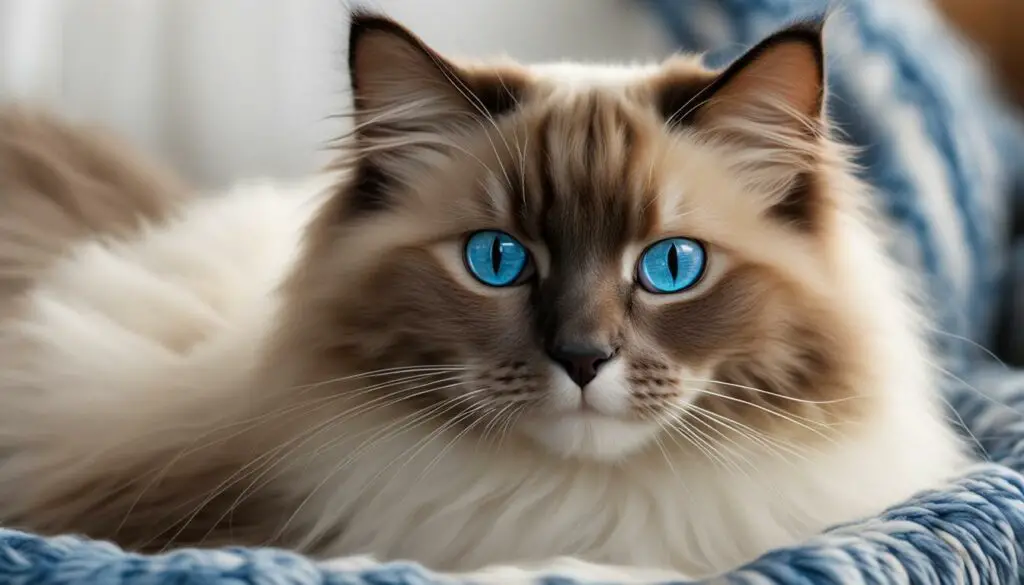
Conclusion
After exploring the factors that contribute to the high cost of Ragdoll cats, it becomes clear that their price is justified. These felines possess unique physical characteristics such as their large size, semi-longhair coat, and gentle temperament, which make them stand out from other cat breeds. The rarity of certain colors and markings further adds to their allure and makes them highly sought after by cat enthusiasts.
While the price of Ragdoll cats may be steep, the love and companionship they bring to their owners make them valuable additions to any household. Their sociable nature and adaptability make them ideal family pets, as they get along well with children and other pets. For those seeking a loyal and low-maintenance companion, Ragdolls are also suitable as solo pets, forming strong bonds with their owners regardless of the household dynamics.
Proper care, grooming, and nutrition are essential for maintaining the health and well-being of Ragdolls. Regular visits to the veterinarian, exercise sessions, and a well-balanced diet tailored to their needs ensure their long-term health. While the cost of Ragdoll cats may be a consideration, the joy and companionship they provide make them a worthwhile investment for cat lovers.
FAQ
Why are Ragdoll cats so expensive?
Ragdoll cats are expensive due to their unique physical characteristics, rarity, and high demand in the feline market.
What factors contribute to the high cost of Ragdoll cats?
The high cost of Ragdoll cats can be attributed to their stunning appearance, large size, distinct physical traits, and their gentle and friendly temperament.
Are Ragdoll cats suitable for families?
Yes, Ragdoll cats are excellent family pets. They are known for their gentle and affectionate nature and get along well with children and other pets.
Do Ragdoll cats require a lot of grooming?
While Ragdolls have low-maintenance coats, they still require regular grooming to prevent matting and tangling. Brushing their semi-longhair coat is necessary to keep it in top condition.
Can Ragdoll cats be trained to perform tricks?
Yes, Ragdoll cats are intelligent and can be trained to perform tricks. They enjoy human interaction and are eager to please their owners.
Why are Ragdoll cats considered low-maintenance pets?
Ragdoll cats are considered low-maintenance pets because of their calm and easy-going temperament. They are not demanding and are content spending time alone. Regular exercise and proper nutrition are essential for their overall health.
What makes Ragdoll cats unique compared to other cat breeds?
Ragdoll cats are unique due to their large size, semi-longhair coat, striking appearance, and their tendency to go limp when picked up, a behavior that enhances their gentle and friendly temperament.
Are Ragdoll cats suitable as solo companions?
Yes, Ragdoll cats are suitable as solo companions. They form strong bonds with their owners and enjoy human interaction, regardless of household dynamics.
Are there rare markings and colors in Ragdoll cats?
Yes, Ragdoll cats can have rare markings such as Lynx Point, Tortie Point, Blaze, Van, and Mitted. Certain color combinations and elusive patterns further enhance their visual appeal.
Why should I consider getting a Ragdoll cat?
Ragdoll cats are known for their beauty, gentle temperament, and sociable nature. They are loving companions, adapt well to different environments, and bring joy to their owners.


